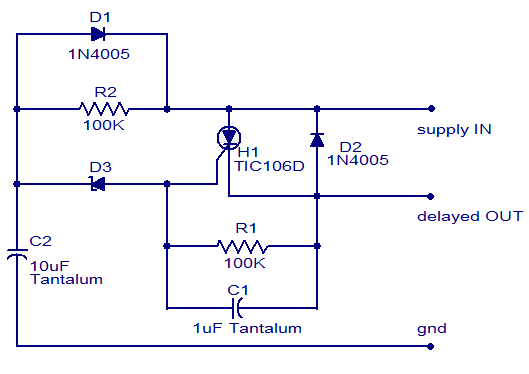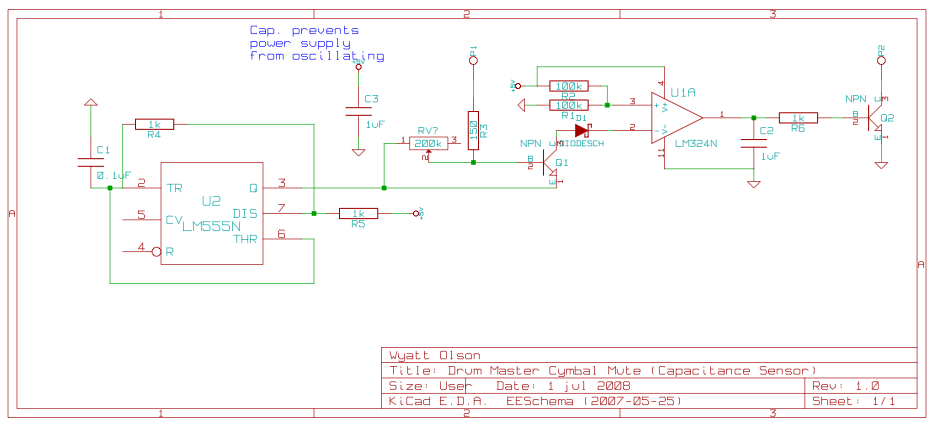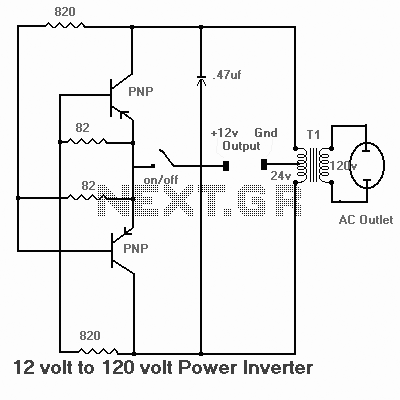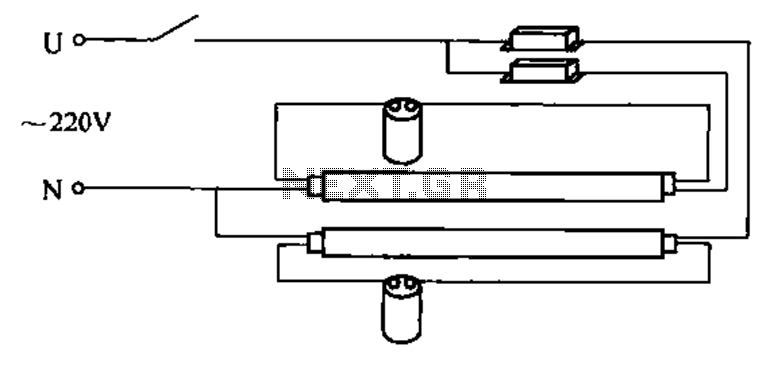
2Y-Y-2 - connection four-speed motor contactor control circuit
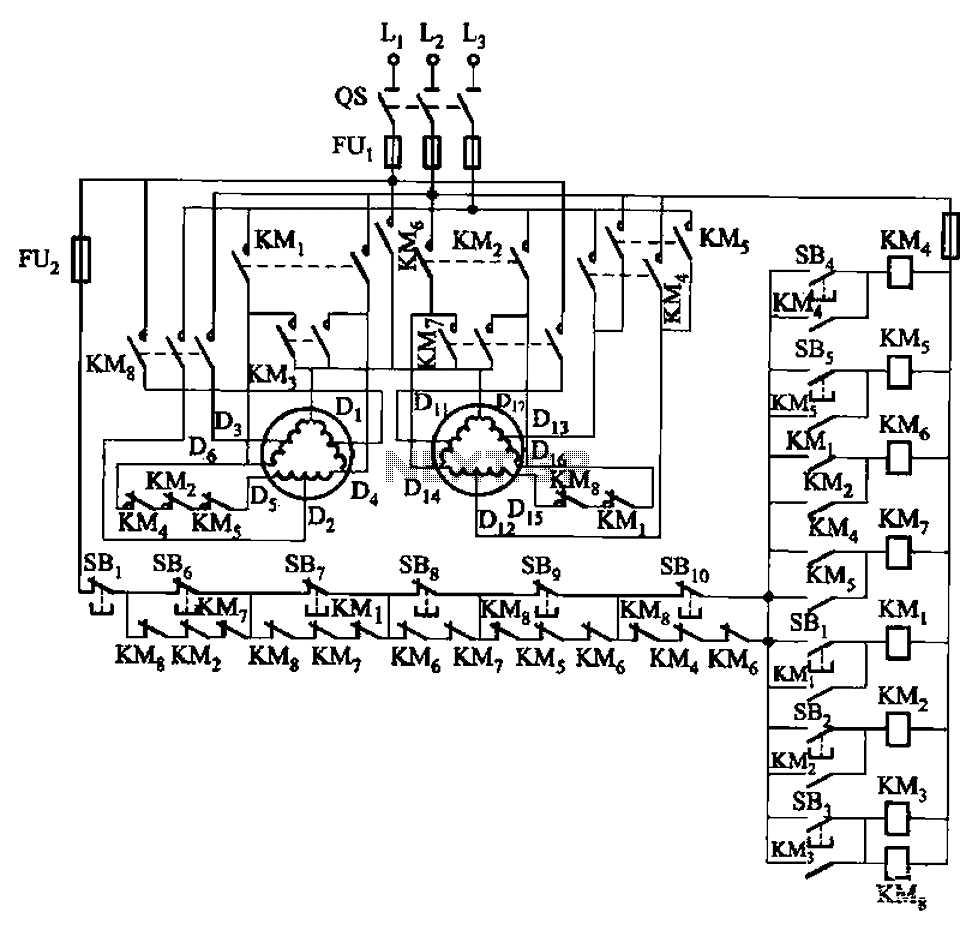
The circuit depicted in Figure 3-120 allows for the control of a motor with a capacity of less than the rated current of 5A by using an intermediate relay instead of a contactor. This circuit enables four forward running speeds and one reverse running speed. It incorporates an interlocking mechanism using a normally closed auxiliary contact of the contactor to prevent simultaneous operation of two speeds. The design permits immediate activation of the corresponding speed when any start button is pressed, without the need to press a stop button beforehand, and the motor can operate at any speed while in use. The connections between buttons include SBl, SB6, SB2, SB7, SB3, SB8, SB4, SB9, and SB10.
This circuit design is aimed at providing efficient control over a small motor while ensuring safety and operational flexibility. The use of an intermediate relay instead of a contactor simplifies the circuit when dealing with lower power requirements, reducing both cost and complexity.
The four-speed forward and one-speed reverse operation is achieved through a series of push buttons (SB1 to SB10) that are wired to control the motor's speed settings. Each button corresponds to a specific speed, allowing for quick adjustments based on operational needs. The interlocking feature is critical; it prevents two speeds from being activated simultaneously, which could lead to system malfunctions or damage. This is accomplished by using normally closed contacts that open when one speed is selected, thereby disabling the others.
The design also emphasizes user convenience, as it allows for immediate motor speed selection without prior stopping. This feature is particularly useful in applications requiring rapid adjustments. The ability to maintain operational speed while engaging the start buttons enhances the circuit's functionality, making it suitable for various applications where quick response times are essential.
In summary, the circuit provides a reliable and efficient method for controlling a small motor with multiple speed settings while ensuring safety through interlocking mechanisms. Circuit shown in Figure 3-120. If the motor capacity is small (less than the rated current 5A), it can use an intermediate relay (contact a few more) instead of the contactor. The line can be achieved in four speed forward running and reverse running one of the most high-speed e matter and cause a short circuit through the circuit for interlocking contactor normally closed auxiliary contact, to ensure that the two speeds can not start it. The line allows any start button is pressed, the corresponding speed can be obtained immediately without having to press the stop button in advance, regardless of motor speed also at work.
Figure, SBl and SB6, SB2 and SB7, SB3 and SBs, SB4 and SBa, SBs are linked with SBao button.
This circuit design is aimed at providing efficient control over a small motor while ensuring safety and operational flexibility. The use of an intermediate relay instead of a contactor simplifies the circuit when dealing with lower power requirements, reducing both cost and complexity.
The four-speed forward and one-speed reverse operation is achieved through a series of push buttons (SB1 to SB10) that are wired to control the motor's speed settings. Each button corresponds to a specific speed, allowing for quick adjustments based on operational needs. The interlocking feature is critical; it prevents two speeds from being activated simultaneously, which could lead to system malfunctions or damage. This is accomplished by using normally closed contacts that open when one speed is selected, thereby disabling the others.
The design also emphasizes user convenience, as it allows for immediate motor speed selection without prior stopping. This feature is particularly useful in applications requiring rapid adjustments. The ability to maintain operational speed while engaging the start buttons enhances the circuit's functionality, making it suitable for various applications where quick response times are essential.
In summary, the circuit provides a reliable and efficient method for controlling a small motor with multiple speed settings while ensuring safety through interlocking mechanisms. Circuit shown in Figure 3-120. If the motor capacity is small (less than the rated current 5A), it can use an intermediate relay (contact a few more) instead of the contactor. The line can be achieved in four speed forward running and reverse running one of the most high-speed e matter and cause a short circuit through the circuit for interlocking contactor normally closed auxiliary contact, to ensure that the two speeds can not start it. The line allows any start button is pressed, the corresponding speed can be obtained immediately without having to press the stop button in advance, regardless of motor speed also at work.
Figure, SBl and SB6, SB2 and SB7, SB3 and SBs, SB4 and SBa, SBs are linked with SBao button.
